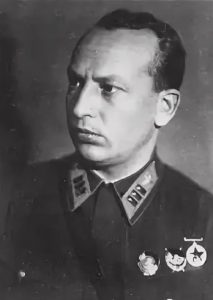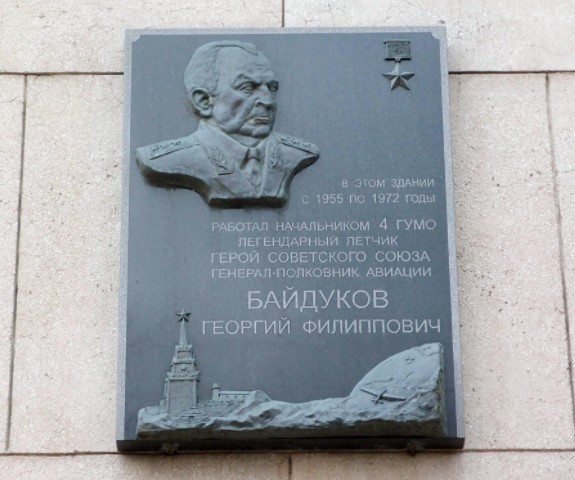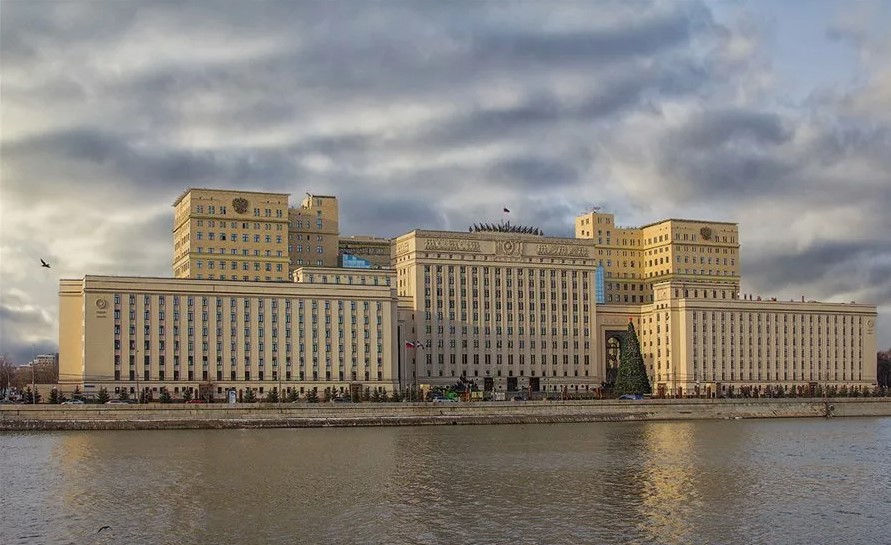Georgy Filippovich
Baidukov
1907-1994

Georgy Filippovich Baidukov was a test pilot of aircraft factory No. 22 (Moscow), co-pilot of the ANT-25 crew, senior lieutenant. He was born on May 13 (26), 1907 at the Taryshta junction of the Kazatkul volost of the Kainsky district of the Tomsk province (now it is Tatarsky district of the Novosibirsk region). Since 1915 he had been wandering. In 1918 he graduated from elementary school in the city of Barabinsk (now it is in Novosibirsk region). He was a laborer on the Omsk railway. In 1924 he graduated from Omsk Railway Vocational School. In 1924-1926 he was a laborer on the Tomsk and Trans-Baikal railways. Baidukov Georgy Filippovich served in the army since March 1926. In October 1926 he graduated from the Leningrad Military Theoretical School of the Air Force, in 1928 – the Kachin Military School of Pilots. He served as a pilot in a separate squadron (in the Moscow Military District). In 1930-1934 he was a test pilot of the Air Force Research and Testing Institute (Air Force Research Institute). He conducted a number of test work on fighter planes, participated in the development of methods of “blind” flights and landings. From November 1934 he studied at the Engineering Faculty of the Zhukovsky Air Force Academy. In March 1935 he was seconded from the Academy to prepare for a transarctic flight on an ANT-25 aircraft. On August 20, 1935 as part of the crew of S.A. Levanevsky he participated in the flight attempt, which was interrupted due to technical problems. After that, he continued further testing of the ANT-25 aircraft. From September 1935 he was a test pilot of aircraft factory No. 22 (Moscow); tested serial TB-3 bombers on July 20-22, 1936 on an ANT-25 aircraft as a co-pilot (commander – V.P. Chkalov, navigator – A.V. Belyakov) made a non-stop flight from Moscow across the Arctic Ocean, Petropavlovsk-Kamchatsky to Udd Island (now Chkalov Island at the mouth of the Amur River) with a length of 9374 kilometers (flight time 56 h 20 min). By the resolution of the Central Executive Committee of the USSR dated July 24, 1936, for carrying out a heroic non–stop long–distance flight on the route Moscow – Arctic Ocean – Kamchatka – Nikolaevsk-on-Amur in extremely difficult conditions of the Arctic and unexplored areas of the Far North, for showing outstanding courage and skill, Baidukov Georgy Filippovich was awarded the title of Hero of the Soviet Union with the award the Order of Lenin. On June 18-20, 1937 an ANT-25 aircraft with the same crew made a non–stop flight Moscow – North Pole – Vancouver (USA) with a length of 8504 kilometers in a straight line (flight time – 63 h 16 min). Simultaneously with the flights, he continued flight testing work at aircraft factory No. 22. He tested serial SB bombers, took part in the tests of the DB-A. On May 14, 1937 he set a world aviation flight speed record on the DB-A aircraft. He was a participant of the Soviet-Finnish War: in January-February 1940, he flew 8 combat missions on a DB-3 bomber as part of the 85th Bomber Aviation Regiment. In March 1940 – August 1941 he was test pilot of aircraft factory No. 22; tested serial bombers Pe-2. In August-December 1941 he was on a government business trip to the United States to purchase American aircraft. He was a participant of the Great Patriotic War: from December 1941 – deputy commander, and in February-March 1942 – commander of the 31st Mixed Aviation Division. In March-May 1942 he was Commander of the Air Force of the 4th Shock Army, in May-June 1942 – commander of the 211st Mixed Aviation Division, in June 1942 – December 1943 – commander of the 212th (from May 1943 – 4th Guards) assault aviation Division. He fought on the Kalinin (December 1941 – March 1943), Voronezh (July-October 1943) and 1st Ukrainian (October-December 1943) fronts. He participated in the Battle of Moscow and the battles in the Belyi direction, in the Rzhev-Sychev, Velikiye Luki, Belgorod-Kharkov operations, the Battle of the Dnieper, Kiev and Zhytomyr-Berdichev operations. In January 1944 – May 1945 he was Commander of the 4th Assault Aviation Corps. He fought on the 1st (June-August 1944) and 2nd (August 1944 – May 1945) Belorussian fronts. He participated in the Bobruisk, Osovetsky, Mlava-Elbing, East Pomeranian and Berlin operations. During the war, he made 10 sorties on an IL-2 attack aircraft. After the war, until July 1945, he continued to command the 4th Assault Air Corps (in northern Germany). In December 1945-July 1946 he was a Deputy Commander of the 13th Air Army (in the Leningrad Military District). He was engaged in active literary activity and was a member of the Union of Writers of the USSR (Russia).
Address: Moscow, Frunzenskaya nab., 22, p. 2

